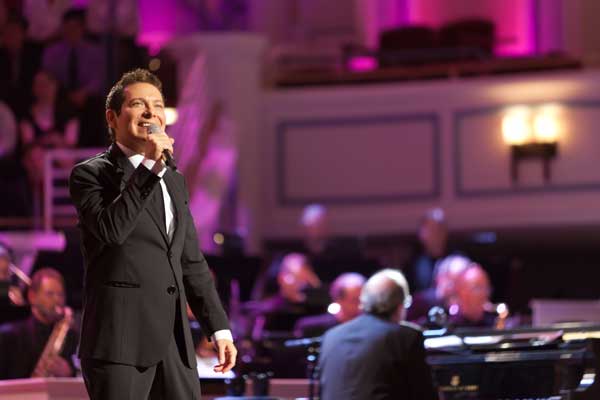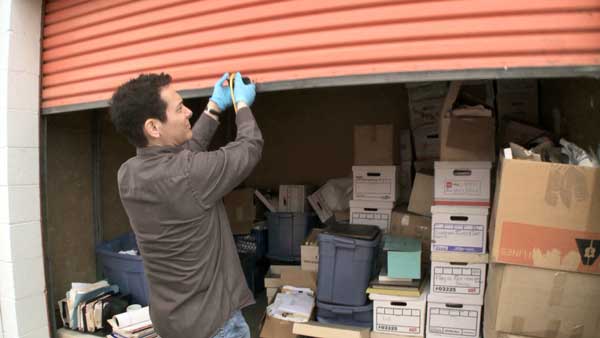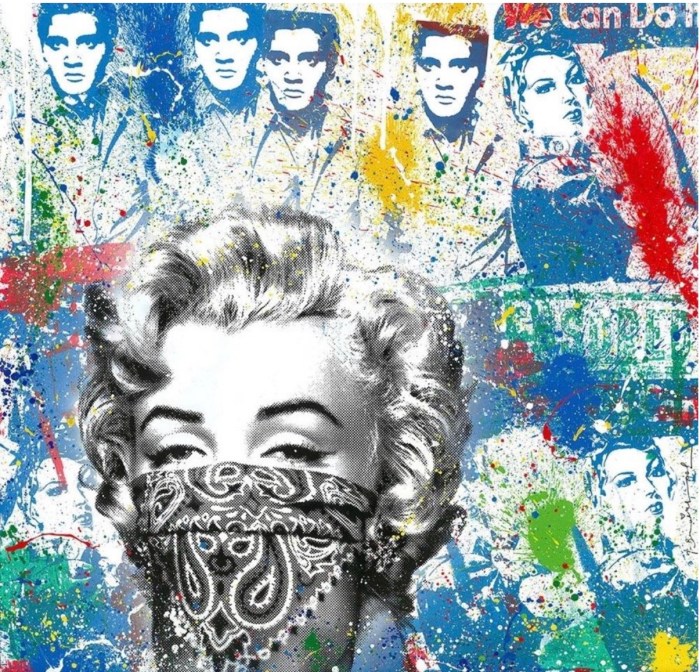 [/media-credit]
[/media-credit]
- Michael Feinstein comes to praise our buried past.
American Songbook guardian, on lost era of irony-free cool
BY SCOTT STIFFLER | Michael Feinstein knows how to make an entrance. He also knows what to do for an encore. That’s good news — because generally speaking, second acts and sequels are ill-advised unless you’ve got something relevant and new to offer. It’s the rare individual who can answer that challenge by mining relevance from old objects scattered along a well-traveled road.
In recent years, the prolific pianist, vocalist and NYC cabaret room namesake (Feinstein’s at Loews Regency) has emerged as our foremost preservationist of American Popular Music. His ubiquitous presence as a much-watched content provider between PBS pledge breaks began in 2010 with Season I of “Michael Feinstein’s American Songbook.” In 2008, he cast new light on the Frank Sinatra canon, with a Grammy-nominated CD (“The Sinatra Project”).
Currently, Feinstein is expanding on those efforts. The second season of his PBS series is looming, and another Sinatra CD was released in October of 2011 (“The Sinatra Project, Volume II: The Good Life”). Both manage to recreate the original’s appeal, while avoiding the sophomore temptation to mimic past glories.
A trilogy within a sequel, the three episodes from Season II of “Michael Feinstein’s American Songbook” see the host excusing himself from his usual perch behind a piano and embarking on a cross-country road trip during which he interacts with all manner of experts, legends and eccentrics. Along the way, we see there’s not much he won’t do to uncover more hidden gems from the likes of Cole Porter, Harold Arlen and Irving Berlin. Feinstein’s relentless pursuit of untold anecdotes and original sheet music finds him mulling over selections from Hugh Hefner’s jukebox, learning a new song from the “trunk” of Jerry Herman and scouring the contents of a storage locker (for which he gamely dons a pair of blue gloves seemingly borrowed from the “CSI” prop table). The final episode, “Saloon of Singers,” has Feinstein tracing the origins of nightclub entertainment all the way from the juke joints of Mississippi to the nocturnal antics of the Las Vegas Rat Pack.
 [/media-credit]
[/media-credit]
That’s part of the reason why Feinstein chose “The Good Life” as the subtitle (and a track) for Volume II. The song, Feinstein explains, “is from the mid-’60s. People were in many ways, if perhaps illusionary, living a good life.” It was also a very good time for Sinatra. “By the 1960s,” recalls Feinstein, “Sinatra had legendary status because of the accumulated body of work. The power of his film appearances and his ubiquity on TV, as well as the dizzying number of hit records and concert albums, made him one of the most celebrated and recognized singers in the world.”
Feinstein pinpoints this era as, “the last decade where there were still a large percentage of American Popular Standards heard on mainstream radio. It was still possible for a song from a Broadway show to become a mainstream hit. That had largely vanished by the ’70s, when singer/songwriters and self-contained pop acts were writing their own songs. So the art of interpreting a songwriter’s words was largely lost. It was also the last decade before economics started to come into play.” Vegas and TV variety shows, he notes, still employed, “a huge orchestra and a huge string section and full production numbers…that connection to a heritage of vaudeville and old-fashioned performing.”
Many of the 12 tracks on “The Good Life” conjure up Vegas and Broadway images of chorus boys and girls executing lavishly choreographed routines amidst a full complement of impeccably dressed musicians. Backed by a 30-member orchestra and the arrangements of producer Bill Elliott, Feinstein comes on like gangbusters from the get-go. The very first track (“Thirteen Women”) is a perfect example of how one’s glamour and cool quotient can be instantly jacked into the stratosphere thanks to a solid wall of horns (whose forceful presence gives a cheeky kick to the narrator’s innuendo-laden tale of romancing female admirers). Of his take on “Thirteen Women,” Feinstein says, “That is probably the most characteristic ’60s arrangement. It’s based to some degree on Ann-Margret’s interpretation. The lineage is fascinating. It was written and performed by Dickie Thompson, as an R&B single. So the original bears no relation to the one Ann did, or to my interpretation.”
That’s typical of the CD’s sly nod not just to Sinatra, but also to the contemporaries who influenced and informed his work. “This is really about the Sinatra circle,” says Feinstein. “The album contains a few songs Sinatra never sang, which was intentional because I wanted to encapsulate that era and show that, though he was still very important, music and styles were changing. It was the ushering in of a new sensibility, and yet the 1960s was still a time when rich, standards-type songs like ‘For Once In My Life’ were still being created alongside newer pop elements like rock and roll.”
As for the title track, Feinstein recalls how “The Good Life” remains, “a song that’s associated with Tony Bennett. His interpretation was probably more visible at the time, more popular. Sinatra recorded it with Count Basie and gave the interpretation a more bluesy swing than Tony did. It was, orchestrally speaking, a more homogenous version.” Feinstein’s approach is unexpectedly downbeat — but skewers more towards quiet introspection than razor-blade-gripping depression. “I did it with just voice and piano, because I wanted to strip the song down to its essence. I felt it didn’t need a band. For me, it’s a song of pathos,” he argues. “Sinatra would often swing a song that was originally a ballad, with varying degrees of success.” Old Blue Eyes did it again with his rousing take on “The Way You Look Tonight.” Sinatra’s use of a swing arrangement, Feinstein says, “to some degree weakens the lyrics, which are so extraordinarily romantic. I did ‘The Way You Look Tonight’ as a ‘What if Sinatra had done this with Antonio Carlos Jobim’ — in a bossa nova arrangement.”
If that seems heretical, Feinstein the historian points out that Sinatra wasn’t immune to criticism of his own interpretive style. Indeed, the notion of a blustery Sinatra striving for authority and relevance (popularized in the 1980s by the impressions of SNL’s Joe Piscopo and Phil Hartman) owes a debt of gratitude to Sinatra’s 1960s venture into Simon & Garfunkel territory. What he did with “Mrs. Robinson,” Feinstein notes, was an example of, “Sinatra trying to be hip and sounding phony. Paul Simon was so upset, he was going to sue [Sinatra], then decided not to if he wanted to live. He has told that story.” Sinatra, Feinstein points out, had much better luck achieving relevance by covering a contemporary work when he put his stamp on “For Once in My Life.” Although now forever associated with Sinatra, that song (track 10 on Feinstein’s CD) at least can be covered without a singer having to worry about crawling out from under Frank’s long shadow. One number you won’t hear Feinstein have his own way with: “My Way.”
“It’s impossible to sing that without thinking of Sinatra,” admits Feinstein. “And for me, it’s impossible to sing anyway, because it’s a terrible song. Sinatra hated that song.”
On CD: THE SINATRA PROJECT, VOLUME II: THE GOOD LIFE
$12.26 (on Amazon.com)
Visit michaelfeinstein.com and feinsteinsattheregency.com
On TV: MICHAEL FEINSTEIN’S AMERICAN SONGBOOK
Airing nationally on PBS
Friday, February 10 & 17, 9-10pm (Episode I aired February 3, will repeat)
For info, visit pbs.org.arts

















